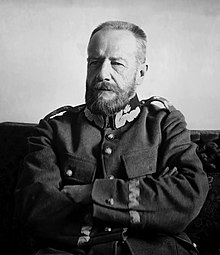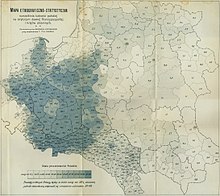Żeligowski's Mutiny
| Żeligowski's Mutiny | |||||||
|---|---|---|---|---|---|---|---|
| Part of Polish–Lithuanian War | |||||||
 Polish soldiers in Vilnius in 1920. | |||||||
| |||||||
| Belligerents | |||||||
|
|
Lithuania | ||||||
| Commanders and leaders | |||||||
|
|
| ||||||
Żeligowski's Mutiny (Polish: bunt Żeligowskiego, also żeligiada, Lithuanian: Želigovskio maištas) was a Polish false flag operation led by General Lucjan Żeligowski in October 1920, which resulted in the creation of the Republic of Central Lithuania. Józef Piłsudski, the Chief of State of Poland, surreptitiously ordered Żeligowski to carry out the operation, and revealed the truth only several years afterwards.
The Second Polish Republic formally annexed Vilnius and its region on 4 March 1922 and the area was recognized by the Conference of Ambassadors as Polish territory on 15 March 1923, which was unrecognized by Lithuania, that claimed Vilnius and its region,[1] and by the Soviet Union.[2] The International Court of Justice in The Hague arbitrated in 1931 that Poland broke international law by occupying Vilnius.[3]
Background

In the summer of 1920, the Polish–Soviet War was ending with the Soviet Russian Red Army defeated at the Battle of Warsaw and in full retreat. The disputed Vilnius region centered on the Lithuanian capital of Vilnius, founded by the Lithuanian Grand Duke Gediminas in 1323, and that had been the Lithuanian capital ever since. Vilnius had been occupied by the Soviets during their summer 1920 westwards offensive. The Soviets returned the region to the Lithuanians because the latter had allowed Soviet troops to move through Lithuanian territory as part of the Soviet–Lithuanian Peace Treaty. Lithuanians also clashed with Poles over territorial disputes as part of the Polish–Lithuanian War.
This move allowed the Soviets to retain tactical control of the region, deny it to the Poles, and increase the already high tensions between the Poles and Lithuanians, both of whom claimed the disputed territory as their own.[4][5]
The Poles rested their claim on then current ethnographic considerations, as approximately 65% of the inhabitants of the city at the time were Polish-speakers, while Lithuanians constituted approximately 1–2% of the city's population.
The negotiations on the future of the disputed area, held under the auspice of a Conference of Ambassadors in Brussels and Paris, reached a stalemate, and Piłsudski feared that the Entente might accept the fait accompli that had been created by the Soviets' transfer of territorial control to Lithuania.
On 10 July 1920, before the Battle of Warsaw, the Polish prime minister
Mutiny


In October 1920, Polish General Lucjan Żeligowski, a native of the historic lands of Lithuania, was given command of the 1st Lithuanian–Belarusian Division (comprising mostly individuals from the Kresy).[11][12] Żeligowski had been contacted by Piłsudski as early as late September 1920 with suggestions to carry out a "mutiny." They prepared a plan by which Żeligowski and forces under his command were to pretend to desert from the Polish Army and then take control of the Vilnius and its region. The Polish government would officially deny its involvement, thereby preserving its reputation on the international scene.[12]
Żeligowski, like Piłsudski himself
In early October, there was intensive preparation for this operation.[14] On October 1, in the meeting of the Polish Council of National Defense, General Józef Haller said:
"It is necessary not only to occupy Vilnius, but also to maybe threaten Kaunas and change the Government of Lithuania."[14]
On October 6, 1920, Żeligowski informed his officers of the plans for mutiny; at that point, no one under his command knew that he was acting with Piłsudski's backing, and some refused to follow him. Support for Żeligowski wavered to such an extent that on October 7, he messaged Piłsudski that he could not carry out the operation due to lack of support among his troops. Eventually, however, most of the officers and men decided to follow him, and he proceeded with the operation.[15]

Żeligowski's forces set out on the morning of October 8 (two days before the Suwałki Agreement ceasefire was to take hold). That day, he declared that he would "liberate Wilno from Lithuanian occupation" and "form a parliament which will decide the fate of the disputed territories."[15]
To ensure a quick conclusion of the operation, Żeligowski was given 14,000 soldiers supported by the Polish 2nd and 3rd Armies.[16] His 1st Lithuanian–Belarusian Division and other units defeated the Lithuanian 4th Infantry Regiment near the Rūdninkai Forest and again in a skirmish near Jašiūnai.[12] The Polish forces reached the vicinity of Vilnius, but were slowed enough to delay their taking the city until the next day. The death toll, as reported by contemporary sources, was low: "a few casualties" on both sides.[17]
The Lithuanian forces in the region were heavily outnumbered: they not only faced Żeligowski's numerically superior regular forces, supported by Polish Army logistics, but also had to garrison Vilnius, whose Polish population was restless. On October 9, the Lithuanian forces were unable to defend Vilnius and evacuated the city, with only token attempts at defending it (the decision to evacuate was made in the afternoon of October 8, and the evacuation took place during the night of October 8–9). When Polish units assaulted the remaining Lithuanian defenses around Vilnius, the city's Polish population supported the Polish troops, with militia units staging an uprising and engaging Lithuanian units still in the city, and civilians welcoming the Polish troops as they entered Vilnius.[citation needed]
Lithuanian government representatives (led by Ignas Jonynas) passed control of the city to the resident Entente officials (led by French colonel Constantin Reboul). Żeligowski, however, refused to recognize their authority, and they were forced to leave the city.[17]

On October 12, Żeligowski proclaimed the independence of the area as the Republic of Central Lithuania, with Vilnius as its capital. Most historians agree that the state was dependent on Poland, but they disagree to what extent (Polish historian Jerzy Jan Lerski calls it a puppet state).[18]
Meanwhile, a uniformed Polish armed force of 20 airplanes and the
Both sides were now exhausted. With the help of the
It was at this time that the close ally of Piłsudski, Michał Pius Römer, a leader of the Krajowcy movement, broke with Pilsudski and made the decision to side with the re-established Lithuanian Republic, even though Piłsudski offered to appoint him Prime Minister of the Republic of Central Lithuania.
Aftermath

Żeligowski became the new state's de facto military

In 1922 Central Lithuania's parliament voted for their state's incorporation into Poland.[24] In 1923, soon after the League of Nations had recognized the existing situation and accepted the Polish-Lithuanian border on March 15, Piłsudski on August 24, 1923 would publicly admit that Żeligowski's Mutiny had in fact been a pre-planned operation carried out with his knowledge and support.[10]
Despite Poland's claim to Vilnius, the League of Nations asked Poland to withdraw. Poland declined. In principle, British and French troops could have been asked to enforce the League's decision. France, however, did not wish to antagonize Poland, a possible ally in a future war against Germany, and Britain was not prepared to act alone. Thus, the Poles were able to keep Vilnius, where a provisional government (Komisja Rządząca Litwy Środkowej, the Central Lithuanian Governing Commission) was formed. Soon parliamentary elections were held and the Sejm of Central Lithuania voted on February 20, 1922, for incorporation into Poland as the capital of a Wilno Voivodeship. The elections were not recognized by the League of Nations.
The League of Nations Conference of Ambassadors accepted the
In Poland, the Mutiny was supported by some groups, such as the
The coup resulted in a serious rift between Pilsudski and Ignacy Jan Paderewski, who had played a major role in creating international support for the independence of Poland.[25] According to historian Timothy Snyder, the annexation of Vilnius by Poles pushed Lithuanian politicians from political towards ethnic understanding of the nation and gave arguments to radical politicians in Lithuania and also in Poland.[26]
Lithuania refused to recognize Central Lithuania.
The Polish-Lithuanian conflict, however, left worsened relations between the two countries for decades to come.[10]
World War II
In September 1939, Poland's
See also
Sources
References
- ^ Allcock, John B. (1992). Border and territorial disputes. Gale Group. p. 146.
- ^ Snyder 2003, p. 78.
- ISBN 9780429862885.
- ^ Łossowski 1995, pp. 112–116.
- ^ Łossowski 1995, pp. 112–128.
- ^ Eberhardt 2003, p. 39.
- ^ Michael MacQueen, The Context of Mass Destruction: Agents and Prerequisites of the Holocaust in Lithuania, Holocaust and Genocide Studies, Volume 12, Number 1, pp. 27–48, 1998, [1]
- ^ Balkelis, Tomas (2020). "A Dirty War: The Armed Polish-Lithuanian Conflict and its Impact on Nation-Making in Lithuania, 1919–23" (PDF). Acta Poloniae Historica (121): 238.
- ^ Łossowski 1995, p. 68.
- ^ a b c d Bojtár 1999, p. 202.
- ^ Łukowski & Stolarski 1994.
- ^ a b c Łossowski 1995, pp. 161–166.
- ^ Snyder 2003.
- ^ a b Butkus, Zenonas; Aleknavičė, Karolina. "Stebuklas prie Vyslos: kaip 1920 metais lenkai sutriuškino bolševikus". 15min.lt (in Lithuanian). Retrieved 2022-03-29.
- ^ a b Łossowski 1995, pp. 175–179.
- ISBN 83-7311-797-0.
- ^ a b Łossowski 1995, pp. 179–185.
- ^ Jerzy J. Lerski, Historical Dictionary of Poland, 966–1945, 1996, Google Print, p. 309.
- ^ a b Łossowski 1991, p. 110.
- ^ Čepėnas 1986, p. 634.
- ^ Łossowski 1995, p. 217.
- ^ Text in League of Nations Treaty Series, vol. 9, pp. 64–67
- ^ Łossowski 1995, pp. 216–218.
- ^ Srebrakowski 1993.
- ^ "Paderewksi's Trip Off; Decides Not to Beard President Pilsudski Over Vilna Coup" (PDF). The New York Times. October 18, 1920. Retrieved May 5, 2009.
- ^ Snyder 2003, p. 69.
Bibliography
- Bojtár, Endre (1999). Foreword to the Past: A Cultural History of the Baltic People. ISBN 963-9116-42-4.
- Čepėnas, Pranas (1986). Naujųjų laikų Lietuvos istorija (in Lithuanian). Chicago: Dr. Griniaus fondas.
- ISBN 978-0-300-10586-5.
Polish sources
- M.E. Sharpe.
- Łossowski, Piotr (1991). Polska-Litwa: Ostatnie sto lat [Poland and Lithuania: the Last Hundred Years] (in Polish). Warsaw: Wydawnictwo Oskar.
- ISBN 83-05-12769-9.
- Łukowski, Grzegorz; Stolarski, Rafal E. (1994). Walka o Wilno: Z dziejów Samoobrony Litwy i Bialorusi, 1918–1919 [The Struggle for Vilnius: the History of the Self-Defense of Lithuania and Belarus, 1918–1919] (in Polish). Adiutor. ISBN 83-900085-0-5.
- Srebrakowski, Aleksander (1993). "Sejm Wileński 1922 roku: Idea i jej realizacja". Historia (in Polish). XCIX. Wrocław.
